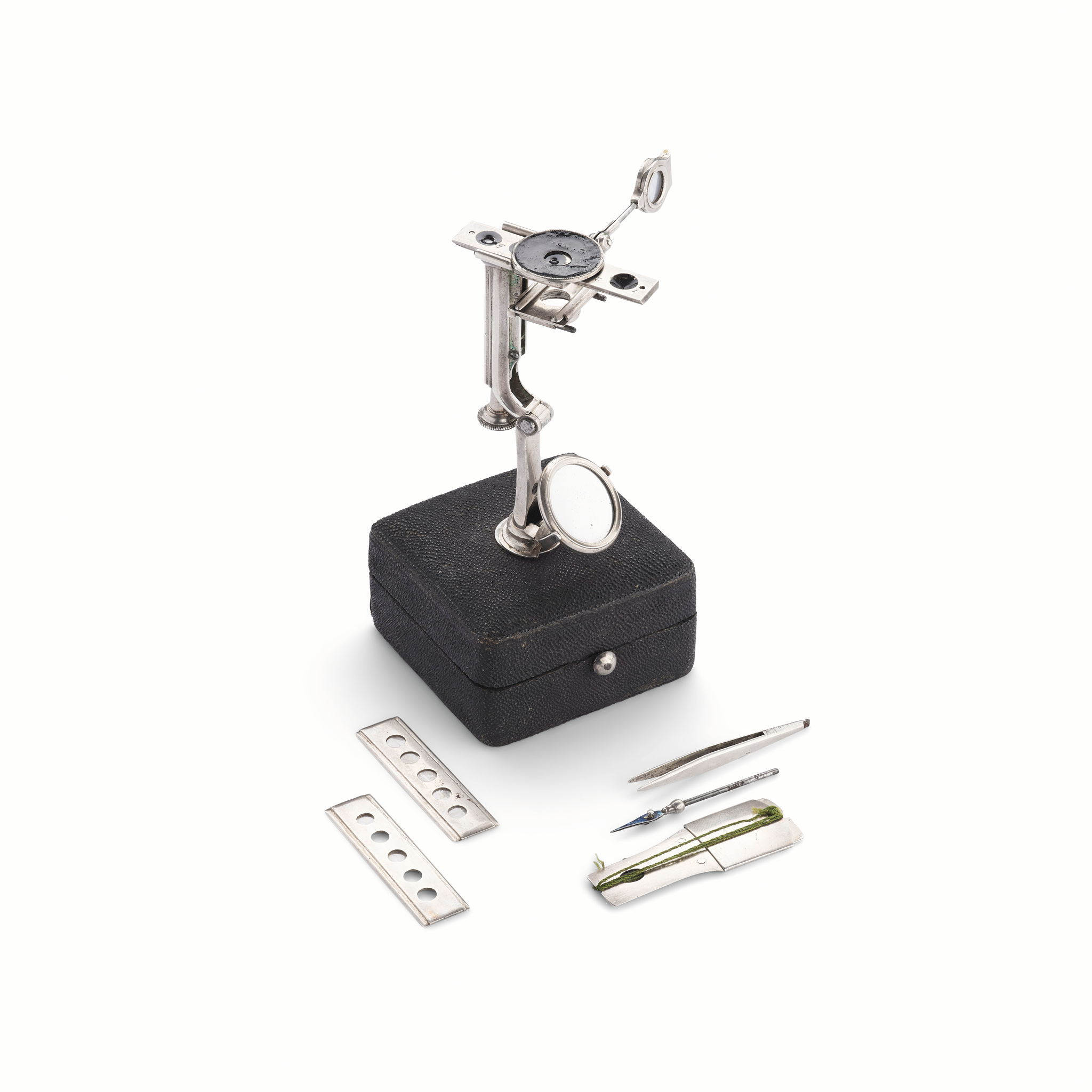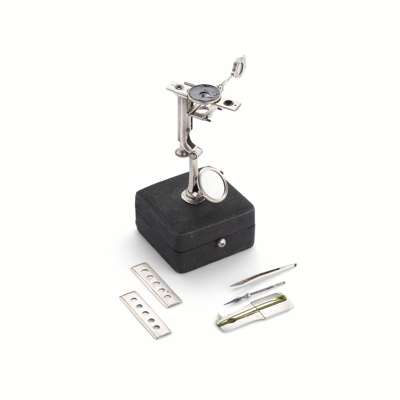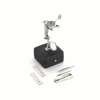
Lot 153

Very rare Scottish George II cased silver simple 'pocket' microscope, John Clark, Edinburgh Y
Circa 1749-1754


The Library of James Stirling, Mathematician
Auction: 23 October 2025 from 13:00 BST
Description
engraved “John Clark Inv. & Fec. Edinb.” to the back, the folding stage frame also with a finely engraved scale to the side and hinged in the middle, the bottom with a rotating concave substage mirror and the top with double operative stages, the upper stage objective viewer with a sliding dovetail slide with five graduated simple objectives, each viewed through the aperture as the slide is pushed through, the lower stage with tracks for two sliding dovetail specimen slides, adjusted with a fine-focus screw, together with a pronged magnifying arm, a delicate blued iron/steel pointer/spike, a pair of silver forceps and a sliding slide-mounter, also with two ivory screwtop boxes containing mica slips (known as talcs) and brass split rings and a small ivory brush with fine hair bristles, all inside a fitted pale blue silk lined black ray skin/shagreen covered case, the domed lid and silver threaded ferrule to the top, forming the supporting stand to secure the microscope, the box 6.5cm square
Footnote
John Clark was an Edinburgh goldsmith, jeweller and optical instrument maker working circa 1749-1796. He advertised twice for subscribers for his first silver simple ‘pocket’ microscope in 1749 and 1751, which was priced at 5 guineas. He advertised again in 1754 for an updated version of his pocket microscope, priced at 4 guineas.
David J. Bryden mentions only one other example of a silver pocket microscope signed John Clark which matched the specifications described in the 1749 and 1751 newspaper advertisements. Referred to by Bryson as the ‘1749 Model’, it was also signed ‘John Clark Inv. & Fec. Edinb.’ It was sold by Sotheby's & Co, London, 2nd May 1966, lot 60, and was believed to have been bought by a Dutch collector. Bryden was aware of six identical examples of the later silver pocket microscope model matching the specifications described in the 1754 advertisements, these were all signed ‘J. Clark fecit Edin'. The present lot is a very rare example of the earliest model of silver pocket microscope by Clark.
‘John Clark was the first Edinburgh instrument-maker to publicise his wares through the medium of the press, and the language of the advertisements for his microscopes clearly indicates the market at which sales were aimed. Pocket microscopes made of silver were advertised for sale by subscription in 1749 and 1754, with a minimum of 50 purchasers required before the manufacture of a batch of instruments was undertaken. By insisting on a down payment from subscribers Clark ensured a viable level of future sales and raised an initial capital from which he could finance the project. Examples of his silver microscopes survive as evidence of the success of the subscription proposals, the second of which was achieved in the face of direct competition from Thomas Henderson, an Edinburgh ironmonger who was retailing London-made microscopes’ (Bryden, 1972, p. 18).
Literature:
Bryden, D. J, Three Edinburgh Microscope Makers: John Finlayson, William Robertson and John Clark, Book of the Old Edinburgh Club, Original Series 33 (1972), pp. 165–176, Plate VI, figure (a), for an illustration of the 1749 design microscope, which presumably is a photograph of the example sold by Sotheby's & Co, London, 2nd May 1966, lot 60.
Bryden, D. J, Scottish Scientific Instrument-Makers 1600-1900, Royal Scottish Museum Information Series, Edinburgh 1972, pp.17-18, Fig. 6, for a photograph of the later model of pocket microscope by Clark dated 1773, and the exert quoted above on the following page.
A comparable example of the 1749 model simple microscope is held in the collection of the National Museums of Scotland, Museum reference T.1984.97.
Please be aware that this lot contains material which may be subject to import/export restrictions, especially outside the EU, due to CITES regulations. Please note it is the buyer's sole responsibility to obtain any relevant export or import licence. For more information visit http://www.defra.gov.uk/ahvla-en/imports-exports/cites/
Sold in compliance with UK Government and APHA regulations, with (non-transferable) exemption registration reference QQMRRFWV

